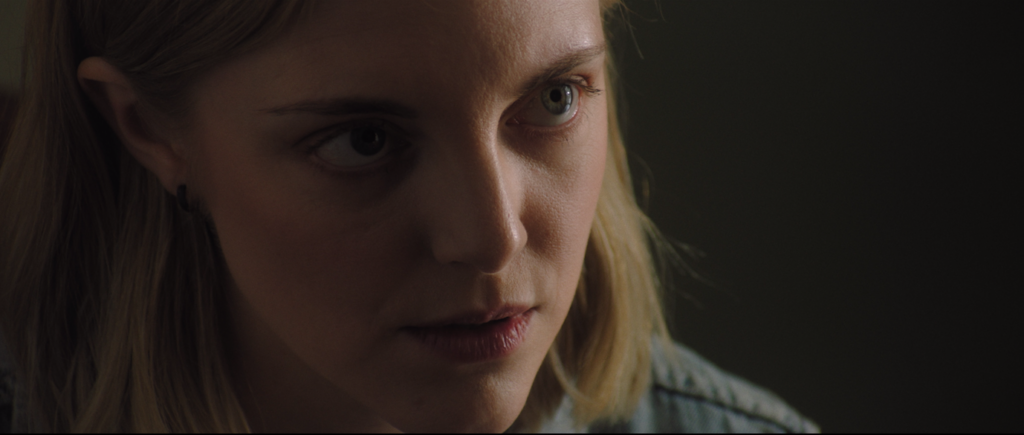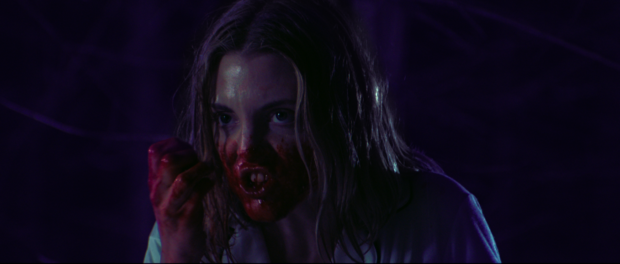Bloodthirsty: A chat with director Amelia Moses
After showcasing her triumphant feature debut Bleed With Me last year, the director Amelia Moses has now returned with her second film Bloodthirsty. Written by the mother-daughter team Wendy Hill-Tout and singer/songwriter Lowell, she took on the important task of bringing this compelling vision to life in front of the camera. I had the opportunity to interview the filmmaker and ask some questions in regards to her latest feature. Without further ado, here we go.

Steven: First of all, congrats on your film! I thought it was a very intriguing character-driven premise that was masterfully mixed in with some genre elements. I was interested from start to finish.
Amelia: Thank you so much!
Steven: After making your feature debut Bleed With Me, you have returned with Bloodthirsty, which had its world premiere at Fantastic Fest last year. What was the experience like of having a festival run for your second film this time around?
Amelia: Well, both were kind of happening at the same time. Bleed With Me premiered at Fantasia in August 2020, and then Fantastic Fest was October 2020. So they were only a few months apart – that was definitely surreal. Then, there was also the fact I shot the films about a year apart. It was weird for them to come out around the same time, especially for me, since they’re very different projects. The process for me was very different. On top of that, there was the fact that everything was online. For Fantastic Fest, it was definitely exciting to get in, but I was sad that it wasn’t happening this year, because I always wanted to go to Austin. It’s a very cool festival.
Steven: Yeah, I also miss the vibe of film festivals, especially meeting both fans and filmmakers. It’s still cool that fests like Fantasia, Fantastic Fest, and Blood in the Snow tried to keep the experience going.
Amelia: Yeah, all the festivals that I’ve been a part of have done a really good job. It definitely feels like a piece is missing, like going for a beer after the screening. That celebratory aspect is missing, which feels a bit disconnected.
Steven: Based on the type of movies you’ve premiered, I can tell you’ve been heavily inspired by genre filmmaking, especially horror. When did you first feel the passion and ambition for it? Can you name some of your influences that you can think of on top of your head?
Amelia: Yeah, I mean I’ve been watching horror movies since I was young. I’ve always been fascinated by them. I grew up watching a lot of Hammer horror films and British horror films in the 60s and 70s. I just like the feel of them, and I’ve always been drawn to the darker side of stories. I then went to film school at Concordia. I just felt like there wasn’t necessarily a space to explore the horror genre in film school, especially since in film school, it just wasn’t something people did too much. So, when I was finishing school, I made a film called Undress Me, which is a body horror short film. It was my first time that I was really committing to being in the genre. It just felt very liberating, and it felt very comfortable. And I guess that kind of leads in to your second question – I’m very influenced by Cronenberg. Undress Me was very influenced by body horror. You know, the kind of degradation of the body or the transformation, which is why I love The Fly and a lot of his earlier work. I’m a big fan of Karyn Kusama, who made The Invitation and Jennifer’s Body, as well. Less so for this film, but for Bleed With Me, The Invitation was a big influence. Those are two filmmakers that I really like.

Steven: For Bloodthirsty, you decided to take on a script written by Wendy Hill-Tout and Lowell. How did that collaboration come about?
Amelia: I actually came on board quite last minute. I think that Lowell and Wendy, who are actually mother and daughter, have been working on the script for quite a few years. It was finally getting into a place of being ready to shoot. And then, I was just looking for some distribution advice for my first feature from a producer in Canada, and I was put in touch with Mike Peterson who’s one of the producers on Bloodthirsty. We were sort of chatting, and we both seemed to really like horror and genre films. Similar sensibilities. And then, he happened to be looking for a director. So I sent him my previous work, and I assumed that the project was still in development and would be in another year or something. But he was like, “Nope, we’re shooting in two months in Calgary.” We actually shot in Edmonton in the end But it all happened very quickly. So I didn’t collaborate too much with them on the script. It was more like working with the actors on set and changing things around.
Steven: It’s always cool for a director to bring a screenwriter’s vision to life.
Amelia: Yeah, it was a brand new experience for me. I was really excited to do that. You’re thinking about directing in a certain way within this overall filmmaking process.
Steven: After Lauren Beatty was one of the lead stars in Bleed With Me, you reunite with her once again for this movie. By the way, she’s also great in Bloodthirsty! How did you get her involved to be cast as the main protagonist for your second feature?
Amelia: Well, when I read the script, I thought of Lauren pretty quickly, because I also just mainly work with her. I knew she was a very talented actor. On top of that, I knew she could sing, which was very helpful for the film.
Steven: It fits the criteria.
Amelia: Yeah, we initially had talked about trying to cast a singer who could also act. But then, we felt like it was stronger to cast an actor who could also sing, especially since acting is a big part of filmmaking. Not only that, Lauren has also written a pop song that I heard a couple of years prior called Gaslight; it’s a beautiful pop song so I knew she also has some songwriting ability. She didn’t write any of the songs in the film, but she knew the creative process and the struggle of writing music as well. So I thought she could add something like that to the table. I also knew that I needed someone who was ready to dive in, and Lauren is very good at throwing herself into things.
Steven: While watching the film, it truly has a different, compelling and unique take on what it’s like to be a werewolf. What was it like to put your own spin on such a well known classic mythology? Was it something that caught your eye in terms of storytelling?
Amelia: I was definitely excited from the get-gp when I heard it was like a werewolf film. I think that the script is a different approach that fed into other decisions when we were shooting. I guess I liked that it didn’t go with the regular things you’re used to seeing, like the full moon. It was more about the emotional transformation, which I thought was very interesting in parallel with the creative process and songwriting side of the film. For me, when I came on board, the decision to do more like a stripped-down werewolf – which is a weird way of saying it – in a hybrid way was kind of predetermined. A lot of it was for budget reasons – if you put someone in a hairy suit, it’s hard to get it right. It can be cheesy. Even CGI can be a difficult thing to get right. So we decided to go for this kind of prosthetic-heavy and exaggerating look, and I just embraced that approach. I also worked with Lauren to get the physicalities, so when we didn’t have the budget to necessarily do tons of transformation elements, she was communicating with her body language. I was pretty inspired by one of my favourite movies An American Werewolf in London, which shows the transformation as a very painful process rather than just actually feeling the visceral nature. That’s also kind of inspired by Cronenberg’s body horror.

Steven: From the intro, it starts out pretty eerie. It does a great job of establishing the tone. It’s also intriguing to see Grey evolve as the movie goes on. For a premise like this, would you say it was difficult to find the right balance of horror and character development?
Amelia: That’s a good question! I feel like for me they’re really intertwined, because I see the horror element as an extension of the character within a film like this. It’s very much her journey and her arc both as an artist and monster. To me, they’re closely intertwined. But in terms of the performance, since Lauren is in almost every scene, and we’re really with her the whole time, what we did between the two of us was break off the script into different keywords of where the character is at emotionally. Even if we were shooting it out of order, we could always reference these words like desire, to keep it grounded in where she’s going and where she came from. Character has always been the forefront for me, and I see the horror element as an extension of that.
Steven: This is absolutely important for me to mention, but congratulations for getting two nominations at the Canadian Screen Awards for Best Original Score and Best Original Song! I would like to give my highest praise to the people who were involved with this.
Amelia: Yeah, Michelle Osis, who did the score, is phenomenal. She wrote it in four weeks. I’m very happy that she’s getting recognition for her work, and for Lowell as well.
Steven: Music is definitely one of the key elements of the story. What was the process like creating both the soundtrack and musical score for the film?
Amelia: The songs that Grey sings in the film are all written by Lowell, and I think most of them were written before I came on board. I remember when Lowell sent me Bloodthirsty, and I was like, “Oh shit! This is a very good track.” At the time, the film wasn’t called that so that’s why we have embraced that as the main song. That was all Lowell’s side of things. She’s a very talented singer-songwriter. For me, it was more about curating the music, figuring out what songs we were gonna hear within the film, and thinking about the lyrics. This also meant working with Lauren to feel a progression of her character, and to feel like the songs were being written on screen. I wanted it to feel more like a stripped-down work-in-progress, and I think that comes across on screen. With the score, we found out we got into Fantastic Fest so we had to finish the film really quickly. Michelle and I had a lot of conversation prior, and we were kind of looking a little bit at some 70s soundtracks of certain films. We had a lot of conversations in the beginning, but the base was still there.
Steven: Lastly, if you can give any advice to a filmmaker wanting to make it in the industry, what would you say to that person?
Amelia: It’s definitively a cliche, everyone says it, but it’s true: make something. Whatever you can do, it’s the best way to learn. You can’t really practice directing. You can watch a lot of movies, which is also good to do. Find the right people you want to work with however you can. Once you do that, you can find your support system, and it becomes a lot easier to get the motivation to make things. But the first step is to make something.
Bloodthirsty is now available on iTunes Canada.






